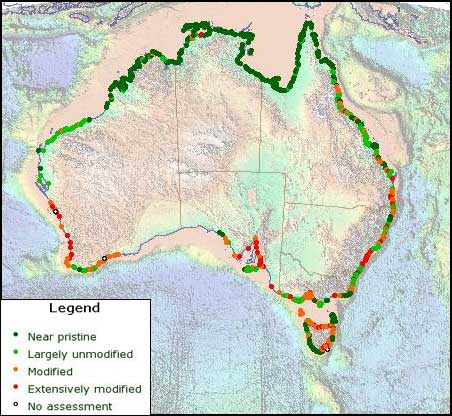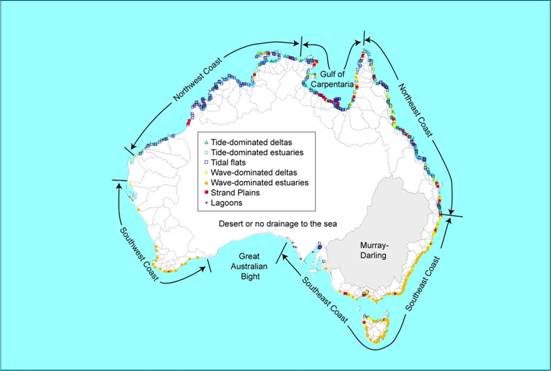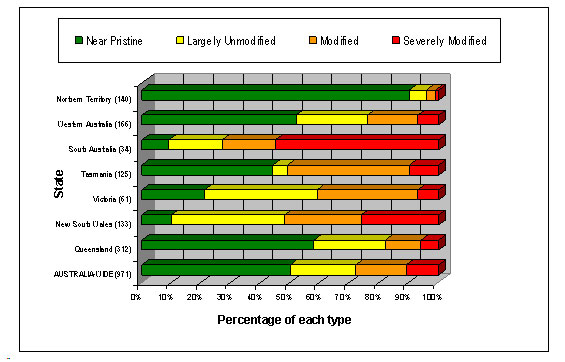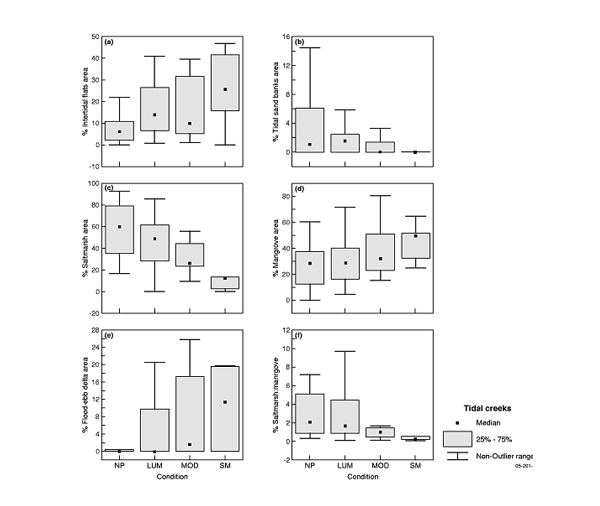Near-pristine estuaries
What are Near-Pristine Estuaries?
Roughly half of Australia’s estuaries were classified as “near-pristine” during the National Land and Water Resources Audit (NLWRA). Near-pristine estuaries are estuaries that have not been impacted upon by humans in significant ways, and are considered to exist in an essentially natural state. This means that the estuaries are not used for aquaculture, that fishing is limited and sustainable and that the water movements through the estuaries and fringing wetlands have not been altered by roads or engineering structures ( e.g. training walls, causeways and barrages). In addition, the catchments of near-pristine estuaries retain most of their natural vegetation cover. As the catchments of near-pristine estuaries are not heavily urbanised nor used for large-scale farming, we assume that the amounts of sediment and nutrients that are delivered to these estuaries in stream flow are near the levels they would be if European-style living and farming practices had never been introduced to Australia. By implication, near-pristine estuaries tend to be located along the most remote and inaccessible parts of the coastline. We tend to know little about Australia´s near-pristine estuaries because they are mainly found in these out of the way places.
This webpage is a central starting point for gaining an overview of Australia’s near-pristine estuaries. It includes two useful clickable maps that:
- Summarise the typical characteristics of estuaries in different geomorphic regions around Australia, using near-pristine estuaries as examples
- Show the distribution of near-pristine estuaries and their geomorphic types throughout IMCRA bioregions
| Physical Characteristics | Condition |
|---|---|
| Catchment natural cover | >90% |
| Land use | Limited roads and disturbance to natural conditions and processes |
| Catchment hydrology | No dams or impoundments, virtually nil abstraction |
| Tidal regime | No impediments to tidal flow, changes from natural morphology (e.g. Training walls, barrages, bridges and causeways) |
| Floodplain | Wetlands intact in vegetation and hydrology, no alterations to flood pattern |
| Estuary use | Extractive activities limited to indigenous or limited and sustainable commercial and recreational fishing, no aquaculture |
| Pests and weeds | Minimal impact on estuary from catchment weeds and limited pests and weeds within estuary |
| Estuarine ecology | Ecological systems and processes intact (e.g. benthic flora and fauna) |
Table 1. The criteria used by the NLWRA to define a near-pristine estuary.

Figure 1. The condition of estuaries around Australia based on the NLWRA assessment 2002.
Why the Interest in Near-pristine Estuaries?
Why the interest in near-pristine estuaries? In the first place, near-pristine estuaries are a valuable part of Australia´s natural heritage. They are important as undisturbed habitat for native plants and animals, and for biodiversity conservation, tourism and fisheries. In addition, by studying near-pristine estuaries, scientists can learn more about natural systems and the ways that human activities have caused them to change. This information then feeds into natural resource management because it constitutes benchmark or baseline information against which similar information from more modified estuaries can be compared. It is also worth mentioning that most countries do not have nearly as many near-pristine estuaries as Australia, and thus may lack this important opportunity for conservation and scientific inquiry.
Aims and Context of the Comparative Geomorphology of Estuaries Project
The central aim of the Comparative Geomorphology of Estuaries Project in the Coastal CRC was to improve our understanding of Australia?s near-pristine estuaries. As the title implies, the project had a geomorphic focus in that a major output was mapping of geomorphic habitats of a representative selection of near-pristine estuaries from around Australia. In the coastal context, geomorphic habitats are landforms (´geo´-´morph´) such as salt marshes and intertidal flats whose shape and position in the landscape are strongly governed by the effect of physical and biological forces on sediments. The mapping follows on from similar work undertaken during the National Land and Water Resources Audit (NLWRA), when the geomorphic habitats of 540 of Australia´s estuaries were mapped (Heap et al., 2001 [PDF 17.4Mb]). However, near-pristine estuaries were poorly represented in the NLWRA process because they were slated for protective management only. Consequently, only 41 near-pristine estuaries were mapped.
Project Achievements and Findings
158 new geomorphic habitat maps of near-pristine estuaries
The geomorphic habitats of 158 near-pristine estuaries were mapped in Comparative Geomorphology of Estuaries Project. The maps are available for down-load in the query the database function in OzCoasts database where they exist alongside the maps of near-pristine and modified estuaries generated during the NLWRA.
The near-pristine estuaries that were mapped in this project were chosen to reflect, as far as possible, the full range of geomorphic variability in Australia: A statistically significant number of the different types of estuaries (between 16 and 26) were chosen, and these were spread as far as practicable around the Australian coastline. Within this context, state preferences and the availability of suitable images and photographs were also taken into account. By estuary types, we refer to the major kinds of coastal waterways ( i.e. wave- and tide-dominated estuaries and deltas, tidal creeks, strandplains and embayments) which experience differing amounts of wave-, tide- and river energy. Each coastal waterway type has a characteristic distribution of different habitats (for example fluvial or bayhead deltas, tidal sand banks, or intertidal flats), and these are depicted conceptually in a report by Ryan et al ., 2003 [PDF 3.9Mb] and in the conceptual models component of OzCoasts.
Near-pristine estuaries from Queensland and the Northern Territory comprised by far the largest proportion of the estuaries mapped during the project, accounting for 46% and 30% respectively. Significantly fewer estuaries were mapped in Tasmania (9%), New South Wales (2%) and Victoria (<1%). This was mainly because there are far fewer near-pristine estuaries in these southern states (see figures 1 and 3), and many of them had already been mapped during the NLWRA. The national set of habitat maps in OzCoasts now includes near-pristine examples of Australia ‘s diverse estuaries and coastal waterways.
Click on each region in the figure below for a summary of the typical characteristics of estuaries for that region.

Figure 2. The coastal geomorphic regions of Harris et al., 2002 [PDF 1.1Mb] and the estuary geomorphic types (Heap et al., 2001 [PDF 17.4Mb]).

Figure 3. A State by State breakdown of estuaries according to condition classification (based on NLWRA data).
A Literature Review on Australia´s Near-Pristine Estuaries
The purpose of the literature review was to collate previously disparate information on near-pristine estuaries, and make it widely available for use by managers, researchers and the general public. This information was acquired through scientific articles, reports, conference proceedings, government agencies, grey literature, web-sites, expert advice and anecdotal observation, and was summarised both on a state-by-state basis and at the national level, with emphasis on current knowledge and management.
The extent and availability of information pertaining to near-pristine estuaries was generally good at the catchment level in most states. Information at the individual estuary level was patchier, although important geomorphic, water quality and ecological studies have been undertaken. An unfortunate finding of the literature review was that a reasonably large percentage of the estuaries deemed to be in near-pristine condition during the NLWRA will likely have to be re-classified to account for modification in either the catchment or in the estuary itself. The occurrence of aquaculture was often cited as the cause for re-classification of estuaries in the southern states, while over-looked catchment modification was the main reason for changes to classifications in Northern Australia . The downstream impacts of cattle grazing on the near-pristine estuaries in northern Australia in particular, is unknown and could be quite extensive.
Land management practices were found to vary greatly across Australia . The catchments of near-pristine estuaries in the southern states are often fully contained within National Parks, while there was a mixture of land tenure in the northern catchments (indigenous, pastoral lease, crown land and freehold) and fewer national parks. Inclusion of the catchments of near-pristine estuaries in National Parks ensures that the estuaries are managed for conservation, and are afforded some measure of protection against future development. This adds to the conservation significance of the estuaries in the framework of a National Representative System of Marine Protected Areas (NRSMPA). With this purpose in mind, tables were provided in each state chapter in which the near-pristine estuaries were assigned to their appropriate coastal IMCRA regions (Interim Marine and Coastal Regionalisation for Australia) to help with future NRSMPA programmes. All IMCRA regions in Queensland , Northern Territory and northern Western Australia had near-pristine estuaries, and the IMCRA regions of Tasmania were reasonably represented by near-pristine estuaries (see figure 4). There are 14 IMCRA regions with no near-pristine coastal waterways along the NSW, VIC, SA and southern WA coastlines.
Click on each state/territory for a close up map of the IMCRA bioregions and geomorphic type of the near-pristine estuaries in that state/territory.

Figure 4. IMCRA bioregions from IMCRA, 1998 [PDF 1Mb], and the geomorphic type of near-pristine estuaries around Australia according to the NLWRA assessment (Heap et al., 2001 [PDF 17.4Mb]).
Remote Sensing Techniques & Applications to Near-Pristine Estuaries
Remote sensing involves the collection of information about the earth’s surface, using sensors mounted on satellites or airplanes. The result of remote sensing is an image from which the spatial distribution of different landscape characteristics ( e.g. mangrove forests and seagrass beds) can be mapped. Remote sensing has been used for many years to map the coastal zone both for research and management purposes. One relevant example was the use of aerial photography to map Australia ‘s coastal geomorphic habitats during the NLWRA. However, it was underscored in the remote sensing methods and applications portion of the Comparative Geomorphology of Estuaries Project that more advanced satellite and /or airborne remote sensing instruments are now available, and these can be even more cost effective and objective than air photo interpretation. This is because the imagery can be collected at larger spatial scales (regional) and because computer software is now available that can help automate the process by which classified maps are made from the images.
Indicators of Estuary Environmental Condition based on the GIS Maps of Estuary Geomorphic Habitats
In a preliminary study, we compared the areas of different habitats of the various types of Australian estuaries on the basis of the NLWRA environmental condition classifications. The results were very encouraging. We found systematic changes in estuary geomorphic indicators with diminishing estuary environmental condition (i.e. from near-pristine, through largely unmodified and modified to severely-modified) for most types of estuaries (e.g., Figure 5). The estuaries that were more disturbed by native vegetation clearance in catchments and development in and around the estuaries had higher levels of geomorphic maturity. This finding indicates that these types of environmental disturbances appear to result in a relatively greater load of sediment moving into the estuary. This was evidenced in apparent increases in the areas of tidal sand banks, intertidal flats and mangroves in tide-dominated estuaries, and in intertidal flats in wave-dominated estuaries. The wave-dominated estuaries also appear to have experienced a marked reduction in salt marsh areas. Our results suggest that higher sediment loads resulting from land clearing have led to pre-mature infilling of some Australian estuaries.
The results of this study thus highlight the potential of the national estuary geomorphic habitat area dataset for providing new insights into the way estuaries react to changes in catchment land use. This is especially the case for many estuaries for which there is a lack of useful historical records.

Figure 5 . Some preliminary results for the geomorphic indicator analysis of Tidal Creeks. These box and whisker diagrams show medians, 25th and 75th percentiles and ranges for the relative area data of the various geomorphic habitats. Environmental condition classifications are: near-pristine (NP); largely unmodified (LM); modified (MOD); and severely modified (SM). Note there are reasonable trends in most of the data.
References
- Murray, E., Radke, L., Brooke, B., Ryan, D., Moss, A., Murphy, R., Robb, M and Rissik, D. 2006. Australia’s near-pristine estuaries: Current knowledge and management. Cooperative Research Centre for Coastal Zone, Estuary & Waterway Management Technical Report #63.
- Creasey, J., Dyall, A., Ticehurst, C., Rogers, B., Radke, L., Brooke, B., Ryan, D., Heap, A., Murray, E. and Dekker, A. 2006. Improving our knowledge of Australia’s near-pristine estuaries: Geomorphic habitat mapping and related applications ? Final Report. Cooperative Research Centre for Coastal Zone, Estuary & Waterway Management Technical Report #64.
- Radke, L., Brooke, B., Ticehurst and E. Murray. 2006. Major achievements of the Comparative Geomorphology of Estuaries project. Cooperative Research Centre for Coastal Zone, Estuary & Waterway Management Technical Report #65.
- Radke, L., Brooke, B., Ryan, D. Lahtinen, A. and Heap, A. 2006. An initial assessment of estuarine geomorphic indicators of coastal waterway health ? Final Report. Cooperative Research Centre for Coastal Zone, Estuary & Waterway Management Technical Report #66.


